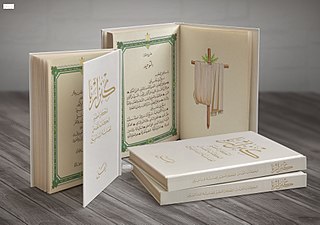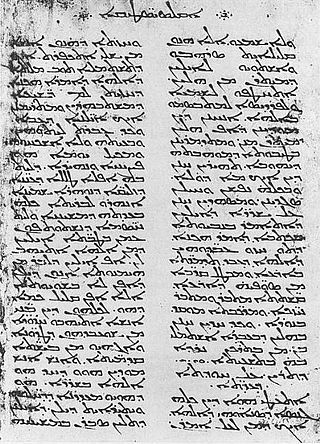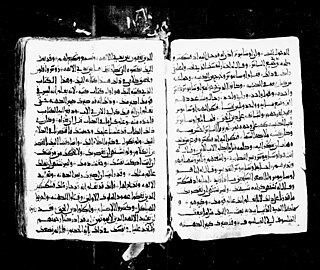Related Research Articles

The Ginza Rabba, Ginza Rba, or Sidra Rabba, and formerly the Codex Nasaraeus, is the longest and the most important holy scripture of Mandaeism. It is also occasionally referred to as the Book of Adam.

The Peshitta is the standard version of the Bible for churches in the Syriac tradition, including the Maronite Church, the Chaldean Catholic Church, the Syriac Catholic Church, the Syriac Orthodox Church, the Malankara Orthodox Syrian Church, the Malabar Independent Syrian Church, the Syro-Malankara Catholic Church, the Assyrian Church of the East and the Syro-Malabar Church.

The Martyrologium Hieronymianum or Martyrologium sancti Hieronymi is an ancient martyrology or list of Christian martyrs in calendar order, one of the most used and influential of the Middle Ages. It is the oldest surviving general or "universal" martyrology, and the precursor of all later Western martyrologies.
Saint Michael the Syrian ,(Classical Syriac: ܡܺܝܟ݂ܳܐܝܶܠ ܣܽܘܪܝܳܝܳܐ, romanized: Mīkhoʾēl Sūryoyo), died 1199 AD, also known as Michael the Great or Michael Syrus or Michael the Elder, to distinguish him from his nephew, was a patriarch and saint of the Syriac Orthodox Church from 1166 to 1199. He is best known today as the author of the largest medieval Chronicle, which he wrote in the Syriac language. Some other works and fragments written by him have also survived.

Syriac is a dialect of Aramaic. Portions of the Old Testament were written in Aramaic and there are Aramaic phrases in the New Testament. Syriac translations of the New Testament were among the first and date from the 2nd century. The whole Bible was translated by the 5th century. Besides Syriac, there are Bible translations into other Aramaic dialects.
Codex Phillipps 1388, Syriac manuscript of the New Testament, on parchment. It contains the text of the four Gospels. Palaeographically it had been assigned to the 5th/6th centuries. It is one of the oldest manuscripts of Peshitta with some Old Syriac readings.
British Library, Add MS 14479, is a Syriac manuscript of the New Testament, on parchment. It is dated by a colophon to the year 534. It is one of the oldest manuscripts of Peshitta and the earliest dated Peshitta Apostolos.
British Library, Add MS 14459, Syriac manuscript of the New Testament, on a parchment. It is dated by a colophon to the year 528-529 or 537-538. It is one of the oldest manuscript of Peshitta and the earliest dated manuscript containing two of the Gospels in Syriac. The manuscript is bound with another dated to the 5th century.
British Library, Add MS 14467, is a Syriac manuscript of the New Testament, according to the Peshitta version, on parchment. Palaeographic analysis has dated the manuscript to the 10th century.
British Library, Add MS 14470, Syriac manuscript of the New Testament, on parchment. Palaeographically it has been assigned to the 5th or 6th century. It is one of the oldest manuscript of Peshitta with complete text of the New Testament.
British Library, Add MS 14448, designated by number 64 on the list of Wright, is a Syriac manuscript of the New Testament, on parchment, according to the Peshitta version. It is dated by a Colophon to the year 699 or 700. The manuscript is a lacunose. Gregory labelled it by 14e, 9a, and 8p . The codex is in the British Library as Add MS 14448.

National Library of Russia, Codex Syriac 1, designated by siglum A, is a manuscript of Syriac version of the Eusebian Ecclesiastical History. It is dated by a Colophon to the year 462. The manuscript is lacunose.
Mar Paul, usually known as Paul of Edessa or Paul of Cyprus, was the Byzantine Syriac Orthodox metropolitan of Edessa who was forced to abandon his see between about 602 and 629, when it fell under the Sasanian Empire. He was an important translator of Greek theological works into Syriac. He should not be confused with the Bishop Paul of Edessa who died in 526.
Mosesof Nisibis was a West Syriac monk and scribe. He was the abbot of Dayr al-Suryan, the Syrian monastery in the Wadi al-Natrun in Egypt, from 914 at the latest. He brought together and helped preserve one of the most important collections of ancient Syriac manuscripts, which is still of critical importance to scholars today.
The Martyrology of 411 is the oldest Eastern Christian martyrology. It is written in Syriac and preserved in one of the oldest Syriac manuscripts, British Library, Add MS 12150, dated to November 411.
Euphemia and the Goth is a romance text of Syriac literature. It is set at Edessa in Mesopotamia in 396 AD but the story appears to have been written in the fifth century AD. The text is known to have survived in two Syriac manuscripts and in a Greek translation.
Thomas of Edessa was a theologian of the Church of the East who wrote several works in Syriac, most of them lost.
The Chronicle of 846 is a fragmentary universal chronicle written in Syriac by an anonymous author sometime between 846 and 873. Its focus for the later centuries, where it is most valuable, is ecclesiastical history. It is written from a Syriac Orthodox perspective.
The Apocalypse of John the Little is an apocalyptic text supposedly given to John the Apostle by revelation. It is dated to the eighth-century AD and pertains to the rise of Islam. The title includes "the Little" which is in reference to John being the younger brother of James the Great. The text models itself from that of the Book of Revelation and the Book of Daniel and provides some of the cruelest surviving Syriac representations of Islamic dominance. It is also one of the earliest text alluding to Muhammad by Christians and possibly one of the earliest accounts of Christians converting to Islam.

The Julian Romance is fictionalized prose account of the reign of the Roman emperor Julian the Apostate. It was written sometime between Julian's death in 363 and the copying of the oldest known manuscript in the sixth century. It was probably written in Edessa in Syriac, the language of all surviving copies. An Arabic adaptation had been made by the tenth century.
References
- 1 2 F. S. Jones (1992), "Evaluating the Latin and Syriac Translations of the Pseudo-Clementine Recognitions", Apocrypha, 3, 237–258. doi : 10.1484/j.apocra.2.301265 There is a "dated Syriac deed of sale found at Dura-Europus, which was evidently written in Edessa in the year 243".
- ↑ James F. Coakley, "Manuscripts", in Gorgias Encyclopedic Dictionary of the Syriac Heritage: Electronic Edition, edited by Sebastian P. Brock, Aaron M. Butts, George A. Kiraz and Lucas Van Rompay (Gorgias Press, 2011; online ed. Beth Mardutho, 2018).
- ↑ Tony Burke (2017), London, British Library, Add. 12150 at North American Society for the Study of Christian Apocryphal Literature (NASSCAL).
- ↑ Oliver Nicholson (2018), "Martyrology of 411, Syriac", in Oliver Nicholson (ed.), The Oxford Dictionary of Late Antiquity , Vol. 2 (Oxford University Press), p. 976, and Christopher Kelly, "Deir al-Suryani", in op. cit., pp. 470–471.
- 1 2 Hatch, William (1946). An album of dated Syriac manuscripts. Boston: The American Academy of Arts and Sciences, reprinted in 2002 by Gorgias Press. p. 52. ISBN 1-931956-53-7.